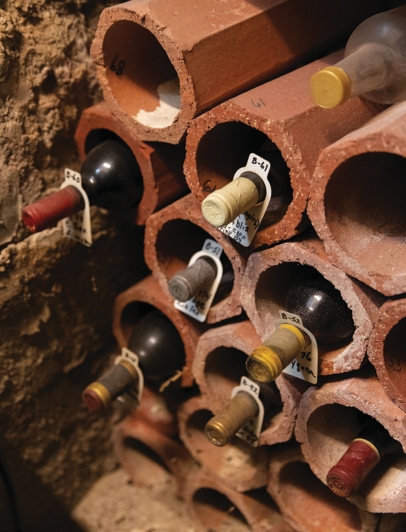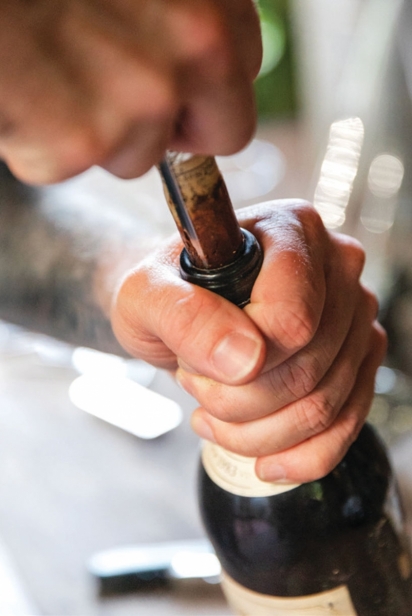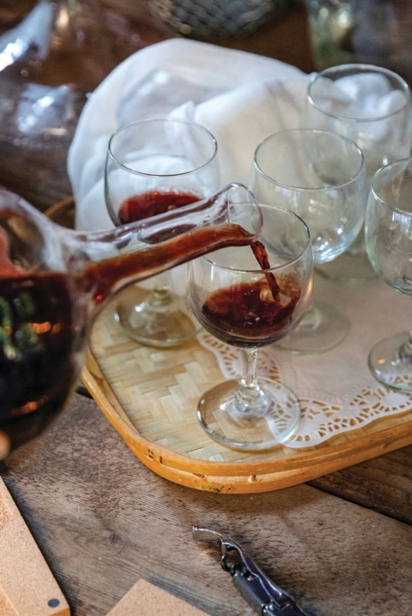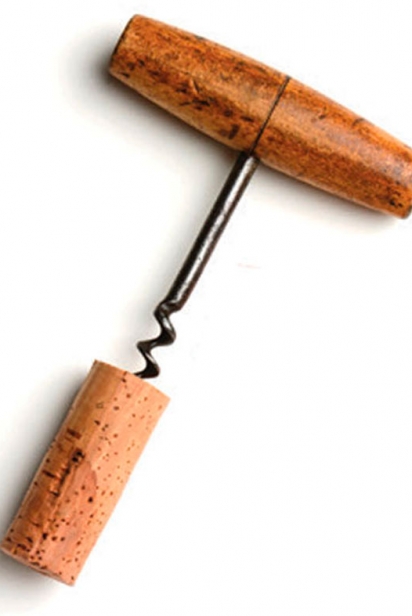In Search of Lost Wine
The best metaphor I know of for aging a bottle of wine is that of a time capsule, a vessel sealed in its present day, stored for discovery in the future. Aging wine is a masochistic exercise in restraint that demands an almost monkish vow of patience. It’s also extravagantly romantic, but one could argue that a world without romance tastes only of vinegar.
It wasn’t until my daughter was born in 2019 that I began seeking out “birth year bottles,” a frequent focus for wine collectors. Through this endeavor, I came to appreciate the ultimate promise of old wine as a means of experiencing time — revisiting a moment, a season, or a year that was somehow memorable. As a wine ages, the tannins (naturally occurring polyphenols found in grape skins, seeds, and stems) undergo polymerization, a reaction that binds them into long chains that then settle to the bottom of the bottle as sediment. In turn, the wine loses its more astringent qualities and takes on a more mature and seasoned vibe as the primary fruit notes give way to secondary and tertiary aromas and flavors. Thus, as we age wine, we capture its essence, its living DNA that will change and evolve, creating new flavors, textures, and aromas that would otherwise fail to emerge.
“It’s not that aged wine is necessarily better, but that a well-aged wine reveals more of itself.”
It’s not that aged wine is necessarily better, but that a well-aged wine reveals more of itself. Assuming the wine in-hand was made authentically, that it’s not a mass-produced “wine product” relying on all manner of chemical inputs to achieve completion, then it’s an indelible snapshot of everything that contributed to its creation: the climate, the terrain, the soil, the winemaker’s style.
Though I’ve spent the last eight years working in the fine wine and spirits industry, it’s only recently that I’ve experienced several truly old bottles. In writing this story, I crossed paths with Karren Napier, a charming and generous woman who has been storing, or “cellaring,” wine for more than four decades. On a hot September evening she invited me and some of the edibleOKC staff to open a few of her oldest bottles. The youngest in the lineup was an ‘83 Beringer Cabernet Sauvignon whose fruit, no doubt bright and fresh at the time of bottling, had congealed into a sort of pungent cassis liqueur minus the sugar. We tasted through a few more bottles, including the star of the show, a 1974 Ridge Zinfandel that had morphed from its classic array of raspberry and black pepper into an earthy, vegetal concoction of tobacco, mint, sage, kirsch, and raw green beans.
Napier began her journey in the early days of Oklahoma City wine culture. She started collecting wine in 1976, at a time when Oklahoma was, by today’s standards, an alcohol wasteland. Some counties were still dry, and even in Oklahoma City, it was illegal to purchase a glass of wine or a cocktail in a restaurant. Liquor stores, while legally able to sell wine, were dominated by cheap sweet wines, ports, and sherries.
“You couldn’t find much in the way of Californian wines in local liquor stores,” Napier says. “But you could store and drink wine in lockers at country clubs for a membership fee, and that’s how several people I knew got the idea to start the Friends of Wine.”
What began as a group of friendly drinkers wanting to acquire the primo stuff soon blossomed into a gang of about 50 members, all of whom sought to expand their palates by any means necessary.
“We were learning how to taste wine, how to save wines, how to know which ones could be stored for the next 10 or 15 years,” Napier says. “We learned how to collect.”
Before long, a sort of makeshift importing operation emerged. An official import business emerged as well: Wayne Hirst, one of the society’s founding members, started Hirst Imports in the same year with the sole goal of bringing premium California wines, including those allocated to Friends of Wine members, into the state. Hirst is often cited as a paradigm-shifter who helped revolutionize Oklahoma’s premium wine import market.
Oklahoma’s laws are no longer draconian, and consumers today have access to an outstanding and diverse selection of wine from all over the world. There’s no excuse to be an uninformed and flippant drinker, but should everyone be a collector?
The first thing to understand is that most wines are not meant to be cellared. Most wines (99 percent of them, in fact) will likely start to deteriorate after about five years; thus, they’re meant to be consumed soon after their vintage date. After about five years, unworthy wines will start to deteriorate and will lose many of their defining characteristics, producing diminishing returns.
When we think of cellaring wine, we think of it as a pastime of the wealthy. Yes, wine collecting can be a very expensive hobby if you want to build a full-fledged cellar complete with temperature and humidity controls and seismic slide rails to prevent even the slightest vibration from disturbing all those sleeping molecules. But you can also cellar on a budget. When Napier started collecting, she was a schoolteacher and her husband was a school principal. The original owners of her home, built in 1924, dug out a tiny cellar about the size of a small pantry inside her basement to serve as a hiding spot for booze during Prohibition. If, like the Napiers, you have a basement or a cellar, you’re in luck. Any room sunk below ground level will naturally have some of the right qualities for storing wine: cool air, low light, and the appropriate levels of ambient humidity.
I store my daughter’s birth-year bottles on a thrift store wine rack in the top of a coat closet, next to my collection of trucker hats. It’s far from ideal, but it’s dark, relatively cool, and will do the trick … at least so I hope. For something in-between, you could buy a dedicated wine fridge or go offsite and opt for a monthly rental with a wine storage company.
In the end, I think it’s important to bear in mind that we’re still talking about fermented grape juice. Sure, we can wax poetic and idolize the experience, but we shouldn’t take wine (or ourselves) too seriously. What I admired most about Napier’s collection wasn’t the wine, but her journal. Every wine she ever saved was assigned a number, and every number corresponded to a line in which she noted where the bottle came from — little inscriptions to remind her of dinners and gifts from friends.
For me, ultimately, it’s about the thrill of the long game, of for-going immediate pleasure for the chance at a greater discovery. The bottle could spoil and betray all your hopes and schemes. But it could also develop in a way that fuses past with present, offering a more resonant joy, a deeper reflection, a moment of genuine surprise. Old wine never gives what is expected. That is both its mystery and its charm.
A few fast facts about old wine
Most wine does not get better with age, so if you’re thinking of collecting, here are a few things to keep in mind:
As a rule of thumb, don’t age any bottle that costs less than $30. Cheaper wines are generally meant to be drunk within a few years.
To age wines for the long haul (10+ years), look for quality wines with high levels of tannin, acidity, and/or residual sugar.
These grapes tend to produce wines that age well: Cabernet Sauvignon, Chardonnay, Pinot Noir, Nebbiolo, Riesling, Syrah … especially from the regions of Bordeaux, Burgundy, Barolo, Chianti, Germany, Napa Valley, Rioja, and the Willamette Valley.
You will need special equipment to enjoy an old bottle. An “ah-so” is a tool for pulling out old corks. A decanter and a strainer are also essential to remove cork debris and sediment.









